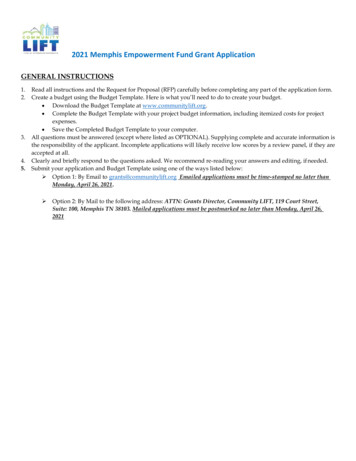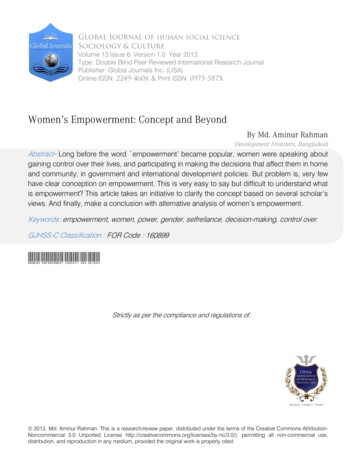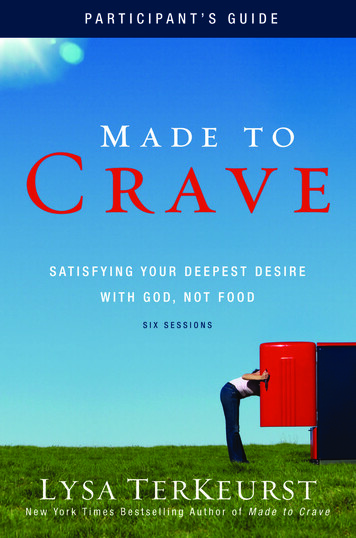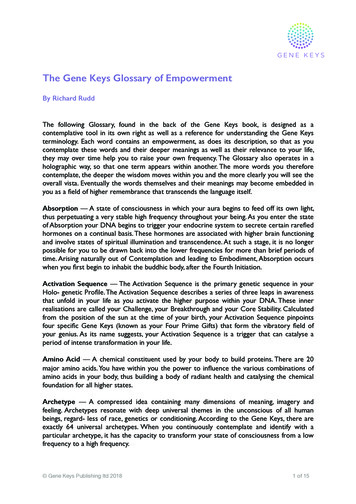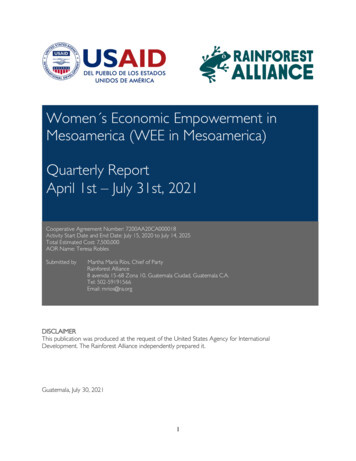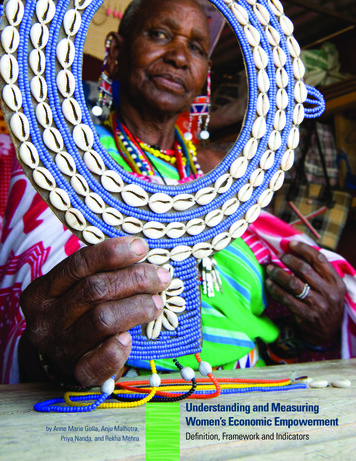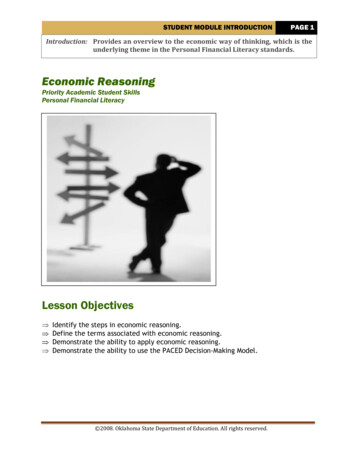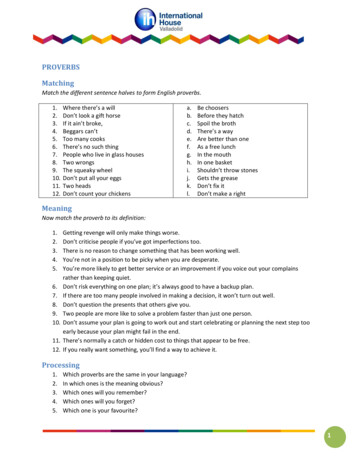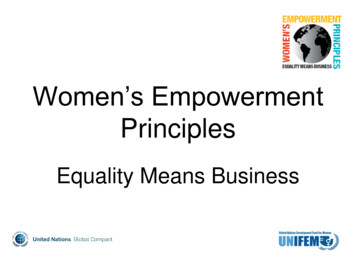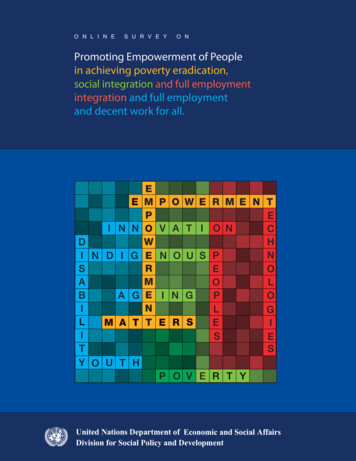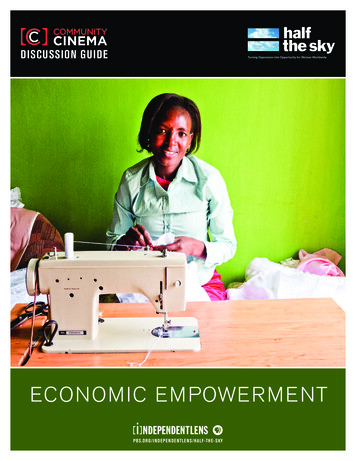
Transcription
DISCUSSION GUIDEeconomic empowermentPbs.org/independentlens/half-the-sky
Table of Contents1Using This Guide2–34–6From the FilmmakerThe Film567–97The Film: Episode OneThe Film: Episode TwoBackground InformationIndividuals Featured in Half the Sky: EconomicEmpowerment in Kenya7Kenya Past and Present8Savings for Women That Saves Women: Ingrid Munro andthe Jamii Bora Microfinance Program9Umoja: Rebecca Lolosoli and Women’s Unity10What is Microfinance?11Economic Empowerment12Benefits of Economic Empowerment13What is Needed?14Thinking More Deeply1516P HOTO CR E DITS: J O S H B E N N ETT, J E S S I CAC H E R MAYE F F, N I C K K R I STO F, J E N N I M O R E LLO,DAVI D S M O LE RSuggestions for ActionResources
Using This GuideCommunity Cinema is a rare public forum: a space for people to gather who are connectedby a love of stories, and a belief in their power to change the world. This discussion guideis designed as a tool to facilitate dialogue, and deepen understanding of the complexissues in Half the Sky: Turning Oppression into Opportunity for Women Worldwide. It isalso an invitation to not only sit back and enjoy the show – but to step up and take action.This guide is not meant to be a comprehensive primer on a given topic. Rather, it providesimportant context, and raises thought provoking questions to encourage viewers to thinkmore deeply. We provide suggestions for areas to explore in panel discussions, in theclassroom, in communities, and online. We also provide valuable resources, and connections to organizations on the ground that are fighting to make a difference.For information about the program, visit www.communitycinema.orgN OT E TO R E A D E R S :This discussion guide gives an overview ofthe entire two-hour Half the Sky: TurningOppression into Opportunity for WomenWorldwide film, and then provides specificbackground information and resourcesfor the country segment that deals withEconomic Empowerment in Kenya.Discussion guide // economic empowerment1
“We wanted to create aunique experience that goesbeyond “issue” filmmaking tosimply tell incredible stories”From the FilmmakerMaro ChermayeffWorking in documentary film has always been an adventure, a pleasure,and a roller coaster ride — but rarely does a project come along thatchanges one’s entire worldview.Making Half the Sky: Turning Oppression into Opportunity for Women Worldwide hastruly been a life-changing endeavor and an honor. The concept for the transmedia projectwas originally brought to me by my fellow executive producers: Jamie Gordon and MikaelaBeardsley. Mikaela had recently produced the film Reporter about the intrepid New YorkTimes columnist Nicholas Kristof. She was very excited when, in conversations in thefield, he talked about his upcoming book to be co-written with his wife Sheryl WuDunnaddressing the struggles and triumphs of women and girls in the developing world thatthey had personally encountered over years of reporting.That book turned out to be the groundbreaking work, also titled Half the Sky: TurningOppression into Opportunity for Women Worldwide, which became an internationalbestseller. The game-changing element of the book is the focus on personal stories thatallow readers to deeply connect with individual, true stories of women and girls facinghorrendous difficulty and inequity. It tackles head on issues such as maternal mortality,sex trafficking, gender-based violence, and forced prostitution — and illustrates the hopeoffered by the life-changing opportunities of education and financial empowerment. Thestorytelling nature of the subject-driven narrative leant itself beautifully to documentary film.As a New Yorker, I knew of Nick’s work as a journalist for The New York Times, and of thehighly regarded Pulitzer Prize-winning articles that Nick and Sheryl had written togetherduring their tumultuous years as reporters based in China, but I had never met eitherof them. Nick and Sheryl believe in the power of social media and the potential of thissubject matter to reach new and diverse audiences through multi-platform content. Thisis where the larger concept of the transmedia project inspired by their book came from.Now, the project is launching on multiple platforms, with a four-hour television series forPBS and international distribution through Fremantle Media; a one hour film for CommunityCinema; free curricula developed for Community Classroom, over 20 short films andeducational modules made in partnership with some of the project’s more than 54 NGOpartners worldwide; mobile games for India and Africa (executive produced with Gamesfor Change with the support of USAID); a social-action Facebook game; and two websites —one housed on PBS.org and another advocacy-based site at halftheskymovement.org.Discussion guide // economic empowerment2
From the FilmmakerAs a filmmaker, the centerpiece ofthe project for me was the documentary series. Filmed in ten countries, theseries is inspired by Nick and Sheryl’swork — but also goes beyond the page tofilm new and immediate stories that lendthemselves to the drama that televisiondemands. Our approach was to orchestrate 2-week trips to six different countries,following Nick as he reported on an agentof change working to better her own lifeor the lives of women in her community.Joining Nick on each leg of the journeywas a different actress who had experience advocating for social issues, butwho was not an expert in the specificissue we were following in that location.Rather, she was there to act as the eyesand ears of the audience, allowing an intimate and honest way into some of thesetough and demanding stories. We had thegood fortune to be joined by Eva Mendesin Sierra Leone, Meg Ryan in Cambodia,Gabrielle Union in Vietnam, Diane Lane inSomaliland, America Ferrera in India, andOlivia Wilde in Kenya.The experience of the shooting was someof the most difficult I have ever experienced in over twenty years of producingand directing large and complicatedseries. Having directed a ten-hour seriesaboard the USS Nimitz on a six-monthdeployment to Iraq (PBS, Carrier), runaway with a traveling circus (PBS, Circus),and made a film about toxic waste beingdumped on a Native American community(HBO, Mann v. Ford), I was prepared forand yet still stunned by the conditions inwhich most people in the world live. I wasespecially affected by the experiencesof women living under these conditions.From rough terrain to blistering poverty,the situations were incredibly challengingand the issues were often heartbreaking.For example, children being raped as earlyas two and three years old in post-conflictSierra Leone or the staggering reality oftrafficking and sexual slavery of younggirls in Cambodia. But the women weworked with were some of the most amazing, courageous, and admirable women Ihave ever known. The tears often flowed.Two of the more emotional experiencesoccurred while trying to help the fourteenyear-old Fulamatu seek justice againstthe uncle who raped her and two of herfriends, only to watch the case crumble,and during the harrowing brothel raid inCambodia with the fiery Somaly Mam thatfreed several under-age girls being heldin slave-like conditions where they wereforced to work as prostitutes with 10-30clients per day.Working with Nick and Sheryl was aninvaluable and amazing opportunity as adirector. I was so impressed by Nick inthe field as he tenaciously sought out thestory and by Sheryl’s incredible ability toDiscussion guide // economic empowermentsee the big picture and address the largeglobal issues. I knew I wanted to honortheir work. We all felt from the start thatit should be an epic production, visuallystunning and visceral, showing the amazing places we visited and people we metin all their beauty. We wanted the realityof their world to be accessible and yet,at times, shocking — an edge-of-your-seatadventure with global significance. Wewanted to tell true stories, yet also deepen people’s experience and understanding of the issues women and girls face inthe developing world. We also believed,and Nick and Sheryl were deeply committed to showing, that the stories couldand should be uplifting and empowering.Even in the darkest of circumstances, wefound the most startling humanity andconfirmation of the human spirit’s resilience. People who engage with all of ourcontent — on the multiple platforms available — will be angry, motivated, inspired,and most important, feel connected to thesubjects and themes. We wanted to create a unique experience that goes beyond“issue” filmmaking to simply tell incredible stories about the capacity of humanbeings to persevere against all odds andthe restorative power of opportunity inparts of the world that are not “over-there,”but a small leap from our own backyard.3
The FilmIn 2009, Pulitzer Prize winning-journalists Nicholas Kristof and Sheryl WuDunn published a ground-breakingbook about the oppression of women and girls worldwide. That book was Half the Sky: Turning Oppressioninto Opportunity for Women Worldwide — an instant bestseller that immediately catalyzed an alreadyburgeoning movement to eradicate gender inequality.The landmark PBS documentary series Half the Sky: TurningOppression into Opportunity for Women Worldwide aims toamplify the central message of the book — that women are not theproblem, but the solution — and to bolster the broad and growingmovement for change. Using the story of the book and its impactas a launchpad, the documentary zeroes in on the lives of girls insome of the countries around the world where gender inequalityis at its most extreme and explores the very real ways in whichtheir oppression can be turned to opportunity.Featuring six celebrated American actresses and the commentaryof the world’s leading advocates for gender equality, the film is apassionate call to arms — urging us not only to bear witness to theplight of the world’s women, but also to help to decisively transform their oppression into opportunity.Episode OneGender-Based ViolenceSierra Leone Eva MendesSex TraffickingCambodia Meg RyanEducationVietnam Gabrielle UnionEpisode TwoMaternal MortalitySomaliland Diane LaneIntergenerational ProstitutionIndia America FerreraHalf the Sky: Turning Oppression intoOpportunity for Women Worldwide is aspecial presentation of Independent Lensbroadcasting on PBS October 1st and2nd, 2012.Half the Sky: Turning Oppression into Opportunityfor Women Worldwide is a production of Showof Force and Fugitive Films in association withIndependent Television Service (ITVS). IndependentLens is jointly curated by ITVS and PBS and is funded by CPB with additional funding provided by PBSand the National Endowment for the Arts.Discussion guide // economic empowermentEconomic EmpowermentKenya Olivia WildeHalf the Sky: Turning Oppression into Opportunityfor Women Worldwide is inspired by Nick Kristofand Sheryl WuDunn’s book of the same name.4
The FilmEpisode OneIn Episode One we follow Nicholas Kristof and three American actresses to developing countries wheregender discrimination is at its most extreme. We explore the shocking extent of gender-based violencein Sierra Leone with Eva Mendes, the global crisis of sex trafficking as experienced by women and girlsin Cambodia with Meg Ryan, and the need for and power of educating girls in Vietnam with GabrielleUnion, where she visits an innovative education program that is transforming, not only the lives of thecountry’s poorest and most vulnerable girls, but also the futures of their families and their communities.Featuring commentary from Sheryl WuDunn and interviews with some of the world’s leading advocates forgender equality — including Hillary Clinton, Michelle Bachelet, and Gloria Steinem — Half the Sky: TurningOppression to Opportunity for Women Worldwide offers a nuanced and moving account of this century’smost pressing problems, and an uplifting, actionable blueprint for change.Gender-Based ViolenceOur first stop is Sierra Leone, a countryrecovering from years of colonial oppression and a terrible civil war and which isstill suffering from rampant gender-basedviolence. Guided by Amie Kandeh, thepassionate and dedicated coordinatorof the International Rescue Committee’sWomen’s Protection and EmpowermentProgram in Sierra Leone, Kristof andactress Eva Mendes come face-to-facewith the enormous challenges women andgirls face in a country where rape is practically the norm — challenges embodiedby Fulamatu, a buoyant 14-year-old whohopes one day to become a bank manager. When we meet Fulamatu she wasraped repeatedly by a local church pastor — a family friend who is close enough tobe officially considered her uncle. She hadrisked the shame of telling her parentsand the ridicule of her community to breakher silence and press charges against theperpetrator. The outcome is a soberingobject lesson in the insidious effects ofgender-based violence, and the urgentneed to end impunity for the violators.Sex TraffickingAs interviews with WuDunn and some ofthe world’s leading advocates for genderequality explain, in many parts of the worldcultural attitudes and traditions are usedto justify the low status of girls, renderingthem vulnerable to all manner of exploitation and abuse. This is nowhere moreevident than in Cambodia, where thepernicious global problem of sex trafficking is perhaps at its worst. Actress MegRyan joins Kristof in Phnom Penh as hecatches up with Somaly Mam, one of thewomen profiled in the book Half the Sky:Turning Oppression into Opportunity forWomen Worldwide — a woman who washerself a child sex slave and who now hasdedicated her life to rescuing and rehabilitating others. As Mam’s story mergesand mingles with those of the girls in hercharge, the horrors of sex trafficking arewrit large — so too is the awesome resilience of the human spirit and the vast,untapped potential that resides in eachand every one of Mam’s girls.EducationThat potential, WuDunn and our luminaryadvocates tell us, is the key to betteringour world: tap into those girls and theywill change the future. The clarity of thatequation, the elegant cause-and-effect ofit, animates Episode One’s final sequence,in Vietnam, where former Microsoft executive John Wood’s organization Room toRead is transforming the lives of the country’s poorest and most vulnerable girls.Hosted by Bich Vu Thi, program officer ofRoom to Read’s Girl’s Education program,Kristof and actress Gabrielle Union getto know a few of the program’s stars andencounter firsthand the incredible obstacles which stand between these girlsand their bright futures. Still, these girlsare almost miraculously undaunted — andfiercely determined to change both theircircumstances and those of their families.The ripple effect of their education evennow is making itself felt — and there is nodoubt that with a little bit of help, a littleencouragement and support, these girlsand the tens of millions of others like themin the developing world will be a powerfularmy for change.Combining vivid, visceral on-the-groundstories with the commentary of a vast andimpressive roster of experts, advocates,and agents of change, Episode One takesus deep into the lives of girls in the developing world and makes us witness to theirseemingly impossible struggles — at oncechallenging and inspiring us to be a partof the vital, urgent project to empowerthem once and for all.Discussion guide // economic empowerment5
The FilmEpisode TwoEpisode Two continues our journey to the hot spots of gender oppression around the world and highlightsthe courageous work of some of the extraordinary women and men who are taking a stand in the faceof incredible odds. This episode focuses our attention on the role of women in their families and theircommunities — examining the fundamental obstacles that hinder their potential, and charting the ripple effectthat results when that potential is harnessed.Veteran journalist and Half the Sky: TurningOppression into Opportunity for WomenWorldwide co-author Nicholas Kristof isonce again accompanied by a three celebrated American actresses who offer freshand personal perspective on the issues ineach country. Kristof travels to Somalilandwith Diana Lane to examine maternalmortality and female genital mutilation,to India with America Ferrera to exploreintergenerational prostitution, and withOlivia Wilde to Kenya, where the transformative power of economic empowermentis changing women’s lives and is layingthe groundwork for the next generation. Inthe process, the film considers the centralrole of women in the health and stability oftheir families and communities and establishes their critical role in the global effortsto eradicate poverty and achieve peace.Featuring on-camera commentary fromSheryl WuDunn and some of the world’smost respected and outspoken advocatesfor gender equality — including MelanneVerveer, Zainab Salbi, and DesmondTutu Episode Two underscores the fundamental obstacles to women’s progressand prosperity and celebrates women’sboundless capacity to better our world.Maternal MortalityThe episode begins in Somaliland — anunrecognized country, populated mainlyby nomads, where the average womantoday has a 1-in-12 chance of dying inchildbirth. Joined by actress Diane Lane,Kristof reconnects with Edna Adan, founder of the Edna Adan Maternity Hospitalin Hargeisa. A spry 70-something womanoften and rightly described as a “force ofnature,” Adam is almost single-handedlyrevolutionizing the experience of childbirthin her country — providing medical care towomen who would otherwise have none,training midwives, and fighting tirelesslyagainst female genital mutilation — a traditional practice still common in much ofAfrica (and elsewhere), which severelycompromises a woman’s ability to delivera child. In Somaliland, the challengeswomen face in the developing world arestarkly apparent: Poverty and traditionconspire to undermine a woman’s health,directly threatening her life, and having alasting impact on her children’s survivaland ability to thrive.Intergenerational ProstitutionAs WuDunn and our cast of gender equality advocates argues, tradition is, in manyways, the greater evil. In too many placesin the world, tradition still is used to marginalize women, to keep them down andin their place. This vicious cycle repeatsitself generation after generation, damaging and ending lives and undermining theability of thousands of women improvetheir quality of life and live their fullpotential. The key — as Kristof and actressAmerica Ferrera discover in India — isintervention by someone from the inside:someone like Urmi Basu. A social workerand an educated, middle-class Bengali,Basu has dedicated her life to stoppingthe cycle of intergenerational prostitutionin India, where 90 percent of girls bornto sex workers follow in their mothers’footsteps. What she is up against is neatlyillustrated by one of the young girls inher care, Monisha, who is on the brink ofbeing wrenched out of school and likelysold to a brothel by her own family — afamily that belongs to a sub-caste of sexworkers. What keeps Basu going is girlslike Sushmita — and more to the point,women like Sushmita’s mother, Shoma,who has lived the utter brutality and desolation of prostitution every day of her lifeand desperately wants a different fate forDiscussion guide // economic empowermenther daughter. Shoma’s hope for her childis the seed of real and lasting change.Economic EmpowermentWhen women have equal control overtheir finances and the financial decisionmaking on the personal, community,and national levels, everyone benefits.WuDunn and the many contributors wholent their voices and considerable expertise to Half the Sky: Turning Oppressioninto Opportunity for Women Worldwideall stress that putting money in the handsof a poor woman changes everything.During their visit to Kenya, Kristof andOlivia Wilde witness the impact of theeconomic empowerment of women firsthand. In this episode’s final segment,they explore the impact and challenges ofmicrofinance and the ways is transforming the lives of women and those aroundthem. We begin with Jane Ngoiri, a formersex worker-turned-dressmaker who is nowable to send her four children to school,where they are each at the top of theirclass, and end with Rebecca Lolosoli, aSamburu woman who built a safe havenfor women on the slender thread of a jewelry-making business. Kristof and Wildesee for themselves the dramatic andtangible transformation that can be set inmotion by a woman with a little money ofher own and a system of support to helpher make the best use of her financial andpersonal resources. Replicate the experiment several million times, and the worldwill be an entirely different place.The episode — and the film — ends withan urgent call to action, an invitation tothe viewer to take up the central moralchallenge of our time, and to join a movement that will tap the immense potentialof women to create a more peaceful andmore prosperous world for us all.6
Background Information“We want to choose our husbands. Wewant to own the land. We want to go toschool. We don’t want to be cut anymore.We also want to make decisions. We wantto participate in politics, to be leaders. Wewant to be equal.”–Rebecca Lolosoli, Founder of UmojaIndividuals Featured in EconomicEmpowerment in KenyaNicholas KristofJournalist; Co-Author of Half the Sky:Turning Oppression into Opportunityfor Women WorldwideSheryl WuDunnJournalist; Co-Author of Half the Sky:Turning Oppression into Opportunityfor Women WorldwideOlivia WildeActress; ActivistIngrid MunroFounder of Jamii BoraJane NgoiriIndependent businesswoman;Member of Jamii BoraRebecca LolosoliCo-founder and matriarch of Umoja,a women-only villageKabeh S. SumboOwner of Passama Agriculture TradingCorporation in LiberiaSources:»» www.bbc.co.uk/news/world-africa-18574734»» itution-kenya»» www.odi.org.uk/resources/details.asp?id 1522&title crisis-kenya-land-displacement»» www.afrol.com/Categories/Women/profiles/kenya women.htm»» enya Past and PresentKenya is a relatively stable African country with a truly multicultural population, whoseethnic diversity has produced a vibrant culture. It is also a country that spent 80 yearsfighting for freedom from colonial rule, only to face four decades of political corruptionthat has undermined its economic and civic development and contributed to the disempowerment of millions of women.The colonial period in Kenya was a time of vicious political and cultural oppression andeconomic exploitation for the indigenous communities who had lived in that region forcenturies. In 1894, Britain declared protectorate over Kenya, and the new state’s boundaries were drawn without the consultation of Kenya’s people. This act arbitrarily broughttogether over 40 previously independent communities into one territorial entity. The ongoing civil unrest that Kenya faces finds its roots in the painful legacy of violence and ethnictension from the country’s colonial era.After achieving independence from Britain in 1963, Kenya’s leader, Jomo Kenyatta,consolidated the political parties under the Kenya African National Union (KANU) party,and by 1969, had banned all other political parties. He was succeeded in 1978 byDaniel arap Moi, who maintained one-party rule under KANU and remained in powerfor 24 years. In the early 1990s, violent unrest and international pressure led to therestoration of multiparty politics, but it took another decade before opposition candidate Mwai Kibaki ended nearly 40 years of KANU-party rule with his landslide victory in2002’s general election.Despite President Kibaki’s pledge to tackle corruption, mismanagement of internationalaid has been a continuing issue, with some donors estimating that up to one billion dollars was lost between 2002 and 2005 alone. In addition to high-level corruption and graft,Kenyans also face crippling daily challenges including high unemployment, widespreadcrime, reoccurring droughts, and extreme poverty, with most Kenyans living on less thanone dollar a day.For Kenyan women, poverty and pervasive traditionalism are the two major obstacles toobtaining equal rights. Although government policy, legislation, and the media favor women’s rights, the traditional view of women’s low status has proven difficult to overcome.Violence against women is a serious problem, with many traditional cultures permittingand even encouraging men to physically discipline their wives. The practice of femalegenital mutilation (FGM) is prevalent, with about 50 percent of Kenyan women havingsuffered FGM. Rape is also widespread despite legal prohibitions, and there is substantial evidence that incidence of child rape is growing. Underlying all of these violations ofwomen’s rights is a deeply entrenched economic discrimination linked to cultural traditions and customary laws that deny women the right to make decisions about their ownresources and to inherit and own land.Recent political improvements — including the new constitution adopted in 2010 thatdelegates more power to local governments and gives Kenyans a bill of rights — haveinspired cautious optimism for many Kenyans. These changes are especially importantfor women who hope to benefit from policies that seek to end gender discrimination andsupport women’s leadership and participation, such as a quota guaranteeing a minimumof 47 women members of Parliament in the National Assembly.Discussion guide // economic empowerment7
Background InformationSavings for Women That SavesWomen: Ingrid Munro and theJamii Bora Microfinance ProgramJamii Bora is the largest and fastest-growing microfinance institution in Kenya. In 1999,Ingrid Munro, a retired civil servant from the Swedish Bureau of Housing Research andformer head of the African Housing Fund (AHF), founded Jamii Bora with 50 Kenyanwomen whose only income at the time was made by begging in the street. Ingrid agreedto loan them twice as much as they agreed to save so they could invest in starting abusiness and acquiring resources that would empower them to generate income andimprove the quality of life for themselves and their families. The project was a success,and since then Jamii Bora, which means “good families” in Swahili, has grown to almosttwo hundred thousand members.Jamii Bora’s lending is concentrated on the needs of its members, and the majority of theloans are very small. The average loan size is around 90 and almost 80 percent of theloans are less than 10,000 Kenyan shillings (about 119). Many of them are starter loansthat could be as small as a few hundred shillings.The first loans usually have a dramatic effect on the lives of Jamii Bora’s members. Asillustrated by the organization, a potato street vendor who has saved KSh 400 can borrow KSh 800 and buy twice as many potatoes from a wholesale vendor. She earns dramatically more for every potato she sells because she bought the potatoes at wholesaleprice and is still selling them at the same price as before. Normally, after three to fourweeks she will come back for her next loan, now having saved KSh 800 and being ableto borrow KSh 1,600 to buy two sacks of potatoes. Jamii Bora has many members whostarted with loans of less than KSh 1,000 and who in one to two years grew into bigbusinesses.Where most microfinance programs in Africa have failed, Jamii Bora has succeeded. Thisis due in part to its microsavings model, which requires every member to participate inthe savings program for at least six weeks before receiving a loan and ensures that loansare never more than twice the amount of the borrower’s savings. Its facilitators also recognize that it is not enough to just lend money—as Ingrid Munro says in the film, “Startingmicrofinance with the poorest of the poor is not something you should do if you’re notready to fight problems every day. To get people out of poverty, you need to deal withevery aspect of their life.”Sources:»» www.halftheskymovement.org»» www.jamiibora.org»» www.ashoka.org/fellow/ingrid-munro»» aitecafrica.com/user/view/Ingrid MunroJane Ngoiri, a Jamii Bora member, is an example of the value of microfinance programsand how they can empower individual women and help break the cycle of poverty fortheir families for generations to come. Jane is a 38-year-old single mom who grew upin the slums of Nairobi, Kenya, and dropped out of school after the eighth grade. Shemarried at age 18, but when she was pregnant with her second child, her husband informally took a second wife. She soon found herself with small children, no home, and nomoney. Jane became a commercial sex worker for five years in order to survive. In 1999,she joined Jamii Bora, where she was pushed to save for the future. She learned to sew,left prostitution, and used her savings and a small loan to buy a sewing machine so shecould repurpose secondhand dresses into children’s clothes. Her business was a success and with the profits she bought a small home in a safe suburb and continues toprovide for her children’s future. Jane still struggles with the costs of raising a family andhas recently discovered that she is HIV positive, but now she has marketable skills, anestablished business, and a positive reputation that she can fall back on in times of crisis.Discussion guide // economic empowerment8
Background InformationUmoja: Rebecca Lolosoliand Women’s UnitySamburu women are among the most marginalized groups in Kenya.The Samburu are a distinct ethnic group in northern Kenya with a culture and languageclosely related to the Masai. The area where the Samburu live is about thirteen thousandsquare miles, with a population of one hundred and sixty-seven thousand. The community lives in manyattas, traditional villages comprised of several huts made of palm leaves,wood, and roofs
book about the oppression of women and girls worldwide. t hat book was Half the Sky: Turning Oppression into Opportunity for Women Worldwide—an instant bestseller that immediately catalyzed an already burgeoning movement to eradicate gender inequality. The landmark PBS documentary series Half the Sky: Turning
